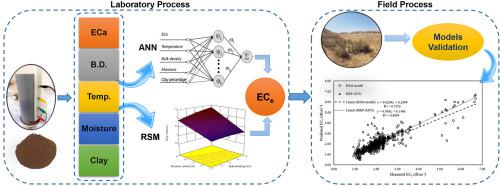Biosystems Engineering ( IF 4.4 ) Pub Date : 2021-03-12 , DOI: 10.1016/j.biosystemseng.2021.02.015 Jalal Baradaran Motie , Mohammad H. Aghkhani , Abbas Rohani , Amir Lakzian

|
Soil apparent electrical conductivity (ECa) is an indirect and rapid measurement for soil salinity, but because of its dependency on some physical and chemical properties of soil in addition to salinity, consideration of the soil extract EC is preferred for monitoring soil salinity, especially in semi-arid areas, though its measurement needs laboratory processes. This study, therefore, sought to develop a multivariable model to estimate the soil ECe from soil ECa, temperature, moisture content, bulk density, and clay percentage, using radial basis function (RBF) artificial neural network (ANN). In the first step, a set of tests was performed in laboratory in Box-Behnken design (BBD) to train the RBF-ANN. The developed RBF estimated the soil ECe with R2 = 0.99 and RMSE = 0.005 dS.m−1. Moreover, a quadratic response surface model (RSM) was also developed to compare with the RBF model. The sensitivity analysis revealed that ECa, moisture, bulk density, and temperature had the maximum to minimum effect on the estimation of soil ECe, respectively. In the second step, the RBF and RSM models were validated by another dataset obtained from three sites located in a semi-arid area. They were applied in-field with a multi-sensor portable device. The R2 and RMSE of the estimation of ECe by the RBF were equal to 0.801 and 0.350 dS.m−1, respectively. While, R2 and RMSE of the RSM model were 0.735 and 0.439 dS.m−1, respectively. The results of the study indicated excellent ability of the RBF-ANN in the rapid and precise estimation of soil ECe.
中文翻译:

一种估算土壤电导率的软计算方法
土壤表观电导率(EC a)是间接和快速测量土壤盐分的方法,但是由于它还依赖于盐分,因此还依赖于土壤的某些物理和化学性质,因此考虑使用土壤提取物EC作为监测土壤盐分的首选方法,尤其是在半干旱地区,尽管其测量需要实验室过程。因此,本研究寻求使用径向基函数(RBF)人工神经网络(ANN)建立多变量模型,以从土壤EC a,温度,水分含量,堆积密度和黏土百分比估算土壤EC e。第一步,在Box-Behnken设计(BBD)的实验室中进行了一组测试,以训练RBF-ANN。发达的RBF估算了土壤EC e其中R 2 = 0.99和RMSE = 0.005 dS.m -1。此外,还开发了二次响应面模型(RSM)与RBF模型进行比较。敏感性分析表明,EC a,水分,堆积密度和温度对土壤EC e的估计分别具有最大至最小的影响。第二步,通过从位于半干旱地区的三个地点获得的另一个数据集验证了RBF和RSM模型。它们与多传感器便携式设备一起现场应用。通过RBF估计EC e的R 2和RMSE分别等于0.801和0.350 dS.m -1。而R 2RSM模型的RMSE和RMSE分别为0.735和0.439 dS.m -1。研究结果表明,RBF-ANN在快速准确地估计土壤EC e方面具有出色的能力。











































 京公网安备 11010802027423号
京公网安备 11010802027423号